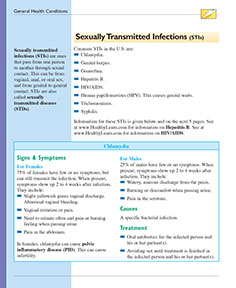Sexual Health
Gonorrhea
Sexually transmitted infections (STIs) are ones that pass from one person to another through sexual contact. This can be from vaginal, anal, or oral sex, and from genital-to-genital contact. STIs are also called sexually transmitted diseases (STDs).
Signs & Symptoms
For Females
Sixty to 80% of females have no symptoms. If present, they appear in 2 to 10 days and include:
• Mild vaginal itching and burning. Thick, yellow-green vaginal discharge.
• Burning when passing urine.
• Severe pain in the lower abdomen.
For Males
Males may have no symptoms, but usually have:
• Pain at the tip of the penis. Thick, yellow, cloudy, penile discharge.
• Pain and burning when passing urine.
Causes
A specific bacterial infection. If it is not treated, it can spread to joints, tendons, or the heart. In females, it can cause pelvic inflammatory disease (PID). This can cause infertility.
Treatment
• Antibiotics.
• Pain relievers.
• Treating sexual partner(s) to avoid getting infected again.
• Follow-up test to find out if the treatment worked.
Questions to Ask
Question
01
Do you have signs and symptoms of any of STIs?

You should be seen by your doctor for medical advice. Contact your doctor or health care provider to find out how soon you should be seen.
x
Question
02
Do you already have a diagnosis of genital herpes and do you have severe pain and blistering and/or are you having outbreaks often?

You should be seen by your doctor for medical advice. Contact your doctor or health care provider to find out how soon you should be seen.
x
Question
03
Are you symptom-free, but worried that you got an STI from someone you think may have one?

You should be seen by your doctor for medical advice. Contact your doctor or health care provider to find out how soon you should be seen.
x
Question
04
Do you want to rule out an STI because you have had many sex partners and you are starting a new sexual relationship or are planning to get married or pregnant?

You should be seen by your doctor for medical advice. Contact your doctor or health care provider to find out how soon you should be seen.
x
Question
05
Do sores appear in the genital area only after taking a recently prescribed medicine?

You should be seen by your doctor for medical advice. Contact your doctor or health care provider to find out how soon you should be seen.
x
Self-Care / Prevention
Safer Sex To Help Prevent STIs
• The only sure way to avoid STIs is not having sex. This includes intercourse, oral sex, anal sex, and genital-to-genital contact. Caressing, hugging, dry kissing, and masturbation are no risk or extremely low-risk practices. So is limiting your sexual contact to one person your entire life. This is if your partner does not have an STI and has sex only with you.
• Latex and polyurethane condoms can help reduce the risk of spreading HIV and other STIs (i.e., chlamydia, gonorrhea, and trichomoniasis). To do this, they must be used the right way for every sex act. They do not get rid of the risk entirely. Barriers made of natural membranes, such as from lamb, do not give good protection against STIs.
• Females and males should use latex or polyurethane condoms every time they have genital-to-genital contact and/or oral sex. Use polyurethane condoms if either partner is allergic to latex. You don’t need condoms to prevent STIs if you have sex only with one partner and neither of you has an STI.
• For oral-vaginal sex and oral-anal sex, use latex dams (“doilies”). These are latex squares.
• Latex condoms with spermicides, such as nonoxynol-9 (N–9) are no better than other lubricated condoms for preventing HIV/STIs. Spermicides with N–9 do not prevent chlamydia, cervical gonorrhea, or HIV. on’t use spermicides alone to prevent HIV/STIs. Using spermicides with N–9 often has been linked with genital lesions which may increase the risk of spreading HIV. Also, N–9 may increase the risk of spreading HIV during anal intercourse.
• Use water-based lubricants, such as K-Y Brand Jelly. Don’t use oil-based or “petroleum” ones, such as Vaseline. They can damage latex barriers.
• To lower your risk for HPV, use latex or polyurethane condoms. These work best at covering areas of the body that HPV is most likely to affect. A diaphragm does not prevent the spread of HPV.
• Don’t have sex while under the influence of drugs or alcohol. You are less likely to use “safer sex” measures.
• Limit sexual partners. Sexual contact with many persons increases the risk for STIs, especially if no protection is used.
• Discuss a new partner’s sexual history with him or her before you start having sex. Know that persons are not always honest about their sexual past.
• Avoid sexual contact with persons whose health status and health practices are not known.
• Follow your doctor’s advice to check for STIs.
Resources
American Social Health Association (ASHA)
CDC National STD Hotline
800.CDC.INFO (232.4636)

Download an offline pdf file.
2021 © American Institute for Preventive Medicine - All Rights Reserved. Disclaimer | www.HealthyLife.com








